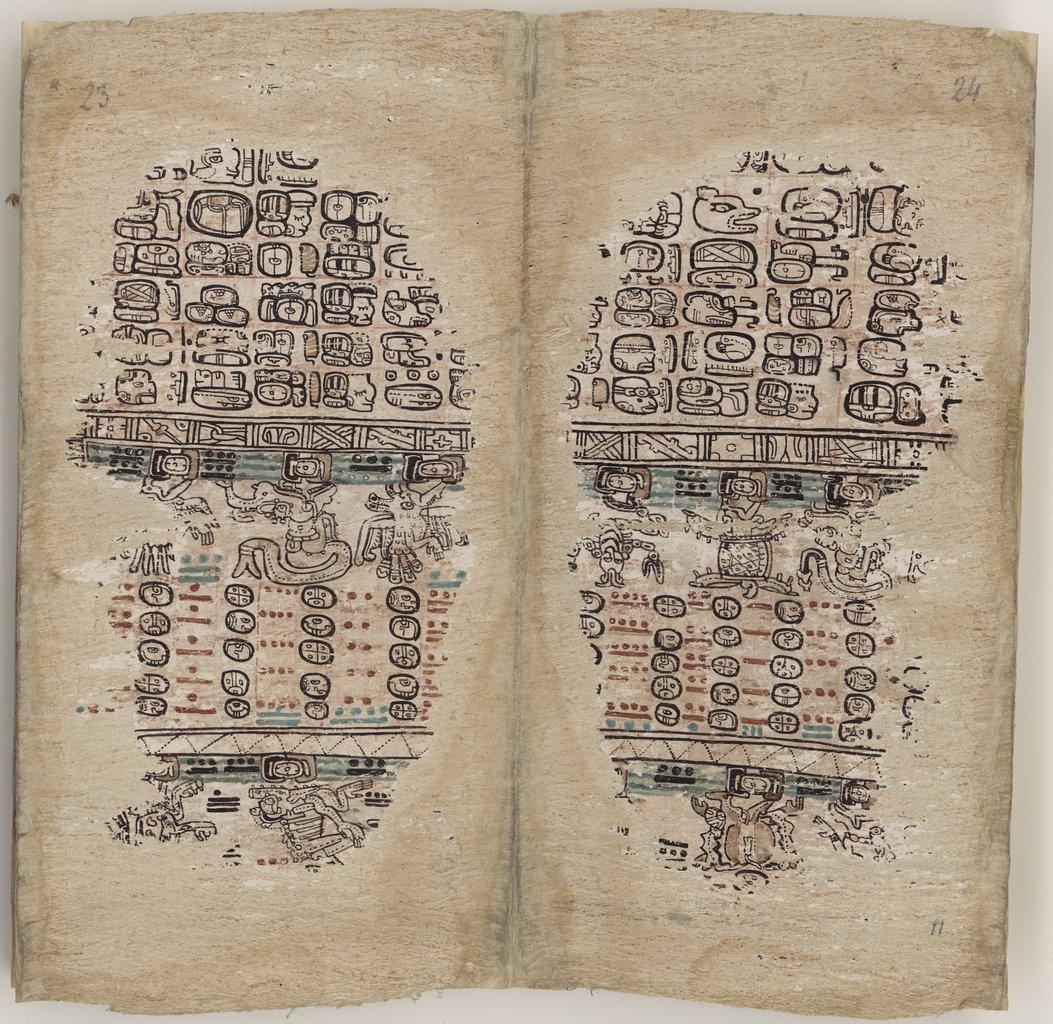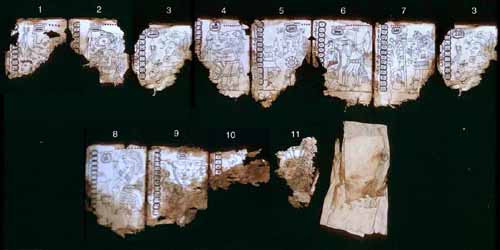Maya Codices
The Maya Codices:

The Dresden Codex:
The Codex:
Origin of the Dresden Codex:
History of the Codex:
Content of the Dresden Codex:
Importance of the Dresden Codex:
The Paris Codex:

The final two pages of the Paris Codex, showing the Maya "zodiac"
The Codex:
Origins of the Paris Codex:
History of the Paris Codex:
Content of the Paris Codex:
Importance of the Paris Codex:
The Madrid Codex:

Scenes connected to the hunt, Madrid Codex
The Madrid Codex, also known as the Tro-Cortesianus Codex, is one of only four remaining books or “codices” attributed to the Ancient Maya culture. The codex consists of 112 pages of glyphs which were not translated until relatively recently. The Madrid Codex describes calendars, rituals and daily activities among the Maya. The original is located in Madrid.
Maya Writing:
The Codex:
Origin of the Madrid Codex:
History of the Madrid Codex:
Content of the Codex:
Importance of the Madrid Codex:
The Grolier Codex:

Grolier Codex is one of the four currently known codices that survived the climate and the invaders from Spain. More controversial than the other three -- the Madrid, Dresden and Paris codices -- the Grolier Codex's authenticity has been a matter of debate.
The codex, although displaying Mixtec stylistic influence, is judged to be Maya (if genuine) based upon the use of bark paper instead of the deerhide preferred for Mixtec codices and because of the presence of Maya day signs and numbering.
The codex is poorly preserved; the surviving page fragments display a number of figures in central Mexican style, combined with Maya numbering and day glyphs. The document is currently held by the Museo Nacional de Antropología in Mexico city and is not on public display. The physics institute of the Universidad Nacional Autónoma de México subjected the codex to non-destructive testing in an effort to determine its authenticity. The results were published in 2007 and were mixed; the document apparently contains genuine pre-Columbian materials but certain aspects, such as seemingly artificially induced wear and tear, are suspect. The researchers concluded that they were unable to prove or disprove the pre-Columbian nature of the codex.
History
The Grolier codex's origin is unclear. It may have been found in the southern region of Mexico-- possibly in the state of Chiapas in a cave somewhere near Tortuguero. It is possible that it was uncovered by looters.
In 1965 it ended up in a Mexico City flea market where someone bought it. The person who bought the codex, a collector, gave it to the Grolier Club so the club could use it in an art exhibition in 1971. Later, in 1973 the Maya specialist Michael D. Coe published a catalog of this exhibition. The claimed discovery of the Grolier Codex would make it the only pre-Columbian codex discovered in the course of the 20th century, except for some codex fragments excavated by archaeologists. Now the Grolier Codex is part of Mexico's Biblioteca Nacional de Antropología e Historia (in Mexico City).
Controversy
Comment
Have questions?
Need help? Visit our Support Group for help from our friendly Admins and members!
Have you?
Donations & Sponsorship
Connect
Visit The Temple
on Facebook:
Blog Posts
Channeled Angelic Wisdom of the Jewels of Truth Series on Beneficence and Heaven on Earth
Posted by Atrayo on April 17, 2024 at 10:26am 0 Comments 1 Like
Channeled Angelic Wisdom of the Jewels of Truth Series on Unconditional Truth and Free Will
Posted by Atrayo on April 14, 2024 at 7:54am 0 Comments 1 Like
Channeled Angelic Wisdom of the Jewels of Truth Series on The Afterlife, God, & World Peace
Posted by Atrayo on April 6, 2024 at 1:51pm 0 Comments 1 Like
coat of arms of McIntyre clan.
Posted by Ghillie Dhu on March 2, 2024 at 5:06am 4 Comments 0 Likes
Channeled Angelic Wisdom of the Jewels of Truth Series on Destiny, Future Past, and Meta-Genesis
Posted by Atrayo on February 22, 2024 at 12:54am 0 Comments 1 Like
Channeled Angelic Wisdom of the Jewels of Truth Series on Sex Addicts and Jealousy
Posted by Atrayo on February 14, 2024 at 6:57pm 0 Comments 1 Like
Are Ouija Boards Evil?
Posted by Bill Walker on February 1, 2024 at 8:15pm 1 Comment 1 Like
PAGAN GLBTQ Pansexual/Hetero ADULT QUANTUM ECLECTIC BOOK LIST - PARTS 1 & 2 - 2024
Posted by Sky a.k.a. JD Aeon on January 7, 2024 at 4:43am 1 Comment 5 Likes
Channeled Angelic Wisdom of the Jewels of Truth Series on The True Sons and Daughters of God, Decision Making, God, and Majesty of Being
Posted by Atrayo on December 29, 2023 at 1:04pm 0 Comments 1 Like
TO RISE AND FIGHT AGAIN
Posted by Kitt on December 14, 2023 at 8:55pm 2 Comments 4 Likes
Channeled Angelic Wisdom of the Jewels of Truth Series on Spiritual Modesty, Exalted, Glories of God, & Grace
Posted by Atrayo on November 29, 2023 at 11:21pm 0 Comments 2 Likes
Osiris the Warlock: The Cursed
Posted by 06iiris on October 13, 2023 at 8:30am 0 Comments 1 Like
Osiris the Warlock: Horus Lives!
Posted by 06iiris on October 13, 2023 at 7:00am 0 Comments 0 Likes
Osiris the Warlock: Nanna-Sin
Posted by 06iiris on October 12, 2023 at 3:30pm 0 Comments 0 Likes
Osiris the Warlock: Daemon
Posted by 06iiris on October 12, 2023 at 6:00am 0 Comments 0 Likes
Osiris the Warlock
Posted by 06iiris on October 12, 2023 at 5:30am 0 Comments 0 Likes
The (3l)ack & Red Dragon
Posted by 06iiris on October 11, 2023 at 1:00pm 0 Comments 0 Likes
The Sin (3l)ood Omen (II)
Posted by 06iiris on October 11, 2023 at 8:30am 0 Comments 0 Likes
The Sin (3l)ood Omen
Posted by 06iiris on October 9, 2023 at 7:30am 0 Comments 0 Likes
The 3nki (Doc)trine: Ptah-Øsiris
Posted by 06iiris on October 5, 2023 at 1:00pm 0 Comments 0 Likes
NOVEMBER AWARENESS
Videos
-
Two Become One
Added by Imelda James 0 Comments 0 Likes
-
You and I Love
Added by Imelda James 0 Comments 0 Likes
-
Deuce - America
Added by Bryan_Thoth 0 Comments 0 Likes
© 2024 Created by Bryan
Powered by
![]()
You need to be an initiate of Exploring Maya to add comments!